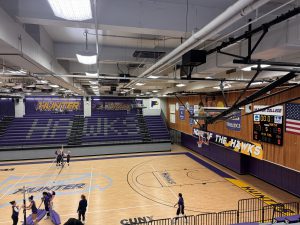Across the United States, college sports are a cultural staple. In Boston, students fill arenas to cheer on Boston University’s hockey team with the energy of the playoff season. Thousands of fans gather to tailgate for Ohio State University football games in Columbus, Ohio. Yet in New York City, despite being home to more than 120 colleges and universities spread across the five boroughs, the city lacks a college sports team that residents can rally around.
For students like Romeo Weis, 20, from Hunter College, the excitement of college sports feels distant. “I see a college football game and don’t care. I think just being from New York, I didn’t grow up watching anything but pro sports,” Weis said, echoing a sentiment felt by many New Yorkers. Major sports teams like the Yankees and Giants dominate local sports, overshadowing collegiate athletics.
A key factor may be the city’s limited number of high-profile college athletic programs. With fewer than five Division I schools, New York trails far behind cities known for strong college sports cultures. New York’s most notable recent collegiate achievement came from Columbia University’s fencing team, which won three national championships in the past decade — an impressive feat, but one that garners little mainstream attention.
This void is felt by students like Olivia Mancino. “Sometimes I see a post on Instagram from someone at a Big Ten school, and I get jealous that we don’t have that here,” she said. In other cities, collegiate teams enjoy support on par with professional teams, sometimes even exceeding them. Cities such as Miami and Austin, for instance, are home to both a passionate pro sports scene and a strong college sports culture.
“It could also be that we barely have a campus,” said Hunter College senior Amanda Lee. “At those sports schools, they all live in dorms and go to school on a normal campus. It’s different here.” NYC campuses, with scattered buildings and high commuter rates, fall short of fostering a strong sense of community.
“I see other students dress head to toe in school gear for support, which is so cool,” said Mancino. For New York students, however, even school merchandise is sparse, making it harder to connect with their college teams. “I don’t even own a Hunter shirt,” she said. Like Mancino and Lee, students believe this lack of school pride takes away from their desire to have a traditional college experience.

This was not always the case. In the 1980s, St. John’s men’s basketball team rivaled—and sometimes even surpassed—the popularity of the city’s professional teams, including the New York Knicks. “My dad was a huge St. John’s fan. He went there in the ’80s when they had a bunch of future pros,” said Baruch College student Michael Perazzo, whose father, Michael Perazzo Sr., was formerly an assistant college basketball coach. “Even when I was a kid we were watching all their games. I still do. So, I don’t know, the scene is small but has the potential to grow,” he said.
University athletes also feel this void. David Kruchefski, a student at Hunter College and the starting forward for the Hunter College men’s basketball team, believes having fans attend games for support is vital.

“Fans showing up to our games gives us that will succeed, and we want to have a community behind us throughout the whole season,” he said enthusiastically, for athletes like Kruchefski, the support from the crowd is what pushes players to give more effort each game. Kruchefski explained that “the support is such a motivation to us as a whole team, knowing that we have a family instead of just classmates. And I can honestly speak for everyone on the team and say that it pushes us to be better for all the fans.”
This year, Hunter students have an opportunity to show that support at the homecoming basketball game on Dec. 6, when the Hawks will face off against Baruch College. For students longing for a sense of school pride, it’s a chance to cheer for their team and build a community spirit that New York colleges often lack.









